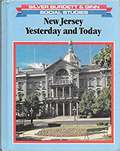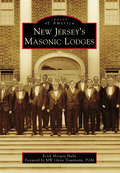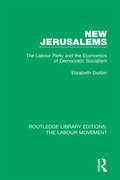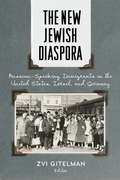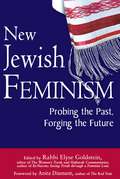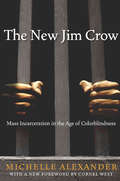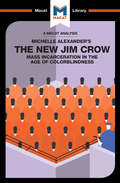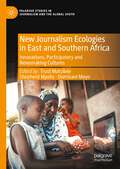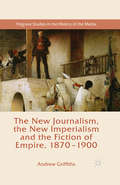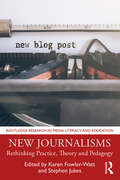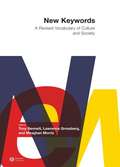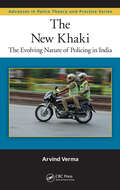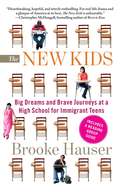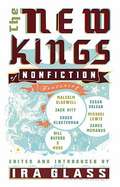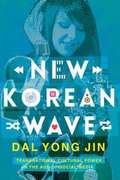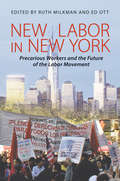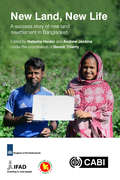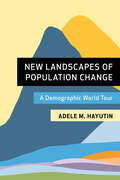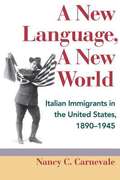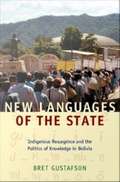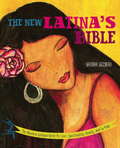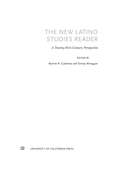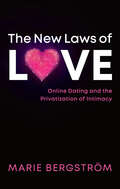- Table View
- List View
New Jersey Yesterday and Today (Silver Burdett & Ginn Social Studies)
by Charles A. Stansfield; Elaine FayA fourth-grade textbook of New Jersey's history with additional material on the state's government, industries, people, and problems.
New Jersey's Masonic Lodges (Images of America)
by Erich Morgan HuhnAcross New Jersey, thousands of men have entered through the doors of Masonic Lodge buildings, also known as "temples," over the fraternity's more than 250-year history in the Garden State. These buildings, from humble meeting spaces to elaborate single-purpose centers, stand tribute to the memory and influence of one of the oldest fraternities in the world, founded on the tenets of faith, hope, and charity. From governors and US Supreme Court justices to carpenters and stonemasons, Freemasonry has welcomed men from all walks of life, and the temples they built have played important roles in the civic, social, and charitable life of many towns. Although some lodges have been lost, many still remain and are presented here for the first time through photographs and images collected from various historical societies, museums, libraries, and Masonic organizations. This book attempts not to serve as an encyclopedic source but rather to catalog and organize the development of the Masonic temples in New Jersey.
New Jerusalems: The Labour Party and the Economics of Democratic Socialism (Routledge Library Editions: The Labour Movement #13)
by Elizabeth DurbinFirst published in 1985. In the 1930s the Labour Party undertook a deliberate search for a viable economic programme to introduce a democratic socialism to Britain. Against the background of the economic turmoil of the period, a group of young economists working for the party thrashed out the theoretical and practical implications of the Keynesian revolution, the planning controversies and the new market socialism. New Jerusalems examines in detail this collective enterprise in economic policy-making. This title will be of great interest to scholars and students of political history.
The New Jewish Diaspora: Russian-Speaking Immigrants in the United States, Israel, and Germany
by Sveta Roberman Uzi Rebhun Jonathan Dekel-Chen Adrian Wanner Nelly Elias Mikhail Krutikov Steven J. Gold Mark Tolts Hannah Pollin-Galay Julia Lerner Marina Sapritsky Zvi Gitelman Elena Nosenko-Shtein Olena Bagno-Moldavski Stephanie Sandler Anna Shternshis Eliezer Ben-Rafael Gur Ofer Yaacov Ro'IIn 1900 over five million Jews lived in the Russian empire; today, there are four times as many Russian-speaking Jews residing outside the former Soviet Union than there are in that region. The New Jewish Diaspora is the first English-language study of the Russian-speaking Jewish diaspora. This migration has made deep marks on the social, cultural, and political terrain of many countries, in particular the United States, Israel, and Germany. The contributors examine the varied ways these immigrants have adapted to new environments, while identifying the common cultural bonds that continue to unite them. Assembling an international array of experts on the Soviet and post-Soviet Jewish diaspora, the book makes room for a wide range of scholarly approaches, allowing readers to appreciate the significance of this migration from many different angles. Some chapters offer data-driven analyses that seek to quantify the impact Russian-speaking Jewish populations are making in their adoptive countries and their adaptations there. Others take a more ethnographic approach, using interviews and observations to determine how these immigrants integrate their old traditions and affiliations into their new identities. Further chapters examine how, despite the oceans separating them, members of this diaspora form imagined communities within cyberspace and through literature, enabling them to keep their shared culture alive. Above all, the scholars in The New Jewish Diaspora place the migration of Russian-speaking Jews in its historical and social contexts, showing where it fits within the larger historic saga of the Jewish diaspora, exploring its dynamic engagement with the contemporary world, and pointing to future paths these immigrants and their descendants might follow.
New Jewish Feminism: Probing the Past, Forging the Future
by Elyse GoldsteinThis empowering anthology looks at the growth and accomplishments of Jewish feminism and what that means for Jewish women today and tomorrow. It features the voices of women from every area of Jewish life-the Reform, Reconstructionist, Conservative, Orthodox and Jewish Renewal movements; rabbis, congregational leaders, artists, writers, community service professionals, academics, and chaplains, from the United States, Canada, and Israel-addressing the important issues that concern Jewish women: Women and Theology, Women, Ritual and Torah, Women and the Synagogue, Women in Israel, Gender, Sexuality and Age, Women and the Denominations, Leadership and Social Justice. Book jacket.
The New Jim Crow: Mass Incarceration in the Age of Colorblindness
by Michelle AlexanderSeldom does a book have the impact of Michelle Alexander’s The New Jim Crow. Since it was first published in 2010, it has been cited in judicial decisions and has been adopted in campus-wide and community-wide reads; it helped inspire the creation of the Marshall Project and the new $100 million Art for Justice Fund; it has been the winner of numerous prizes, including the prestigious NAACP Image Award; and it has spent nearly 250 weeks on the New York Times bestseller list. <p><p>Most important of all, it has spawned a whole generation of criminal justice reform activists and organizations motivated by Michelle Alexander’s unforgettable argument that “we have not ended racial caste in America; we have merely redesigned it.” As the Birmingham Newsproclaimed, it is “undoubtedly the most important book published in this century about the U.S.” <p><p>Now, ten years after it was first published, The New Press is proud to issue a tenth-anniversary edition with a new preface by Michelle Alexander that discusses the impact the book has had and the state of the criminal justice reform movement today.
The New Jim Crow: Mass Incarceration in the Age of Colorblindness
by Michelle Alexander Cornel West<P>Once in a great while a book comes along that changes the way we see the world and helps to fuel a nationwide social movement. The New Jim Crow is such a book. <P>Praised by Harvard Law professor Lani Guinier as "brave and bold," this book directly challenges the notion that the election of Barack Obama signals a new era of colorblindness. With dazzling candor, legal scholar Michelle Alexander argues that "we have not ended racial caste in America; we have merely redesigned it." <P>By targeting black men through the War on Drugs and decimating communities of color, the U.S. criminal justice system functions as a contemporary system of racial control--relegating millions to a permanent second-class status--even as it formally adheres to the principle of colorblindness. In the words of Benjamin Todd Jealous, president and CEO of the NAACP, this book is a "call to action.<P><P> <P><b>A New York Times Bestseller</b>
The New Jim Crow: Mass Incarceration in the Age of Colorblindness
by Ryan MooreMichelle Alexander’s The New Jim Crow: Mass Incarceration in the Age of Colorblindness is an unflinching dissection of the racial biases built into the American prison system. Named after the laws that enforced racial segregation in the southern United States until the mid-1960s, The New Jim Crow argues that while America is now legally a colorblind society – treating all races equally under the law – many factors combine to build profound racial weighting into the legal system. The US now has the world’s highest rate of incarceration, and a disproportionate percentage of the prison population is comprised of African-American men. Alexander’s argument is that different legal factors have combined to mean both that African-Americans are more likely to be targeted by police, and to receive long jail sentences for their crimes. While many of Alexander’s arguments and statistics are to be found in other books and authors’ work, The New Jim Crow is a masterful example of the reasoning skills that communicate arguments persuasively. Alexander’s skills are those fundamental to critical thinking reasoning: organizing evidence, examining other sides of the question, and synthesizing points to create an overall argument that is as watertight as it is persuasive.
New Journalism Ecologies in East and Southern Africa: Innovations, Participatory and Newsmaking Cultures (Palgrave Studies in Journalism and the Global South)
by Trust Matsilele Shepherd Mpofu Dumisani MoyoThis volume presents case studies of news media employing and integrating social media into their news production practices. It links social media use to journalistic practices and news production processes in the digital age of the Global South. Critically, the chapters look at seminal cases of start-up news media whose content is informed by trends in social media, ethical considerations and participatory cultures spurred by the wide use of social media. There has been considerable research looking at the potential of new media technologies, traditional journalism and citizen reporting. The extent to which these new media technologies and ‘citizen journalism’ have morphed or reconfigured traditional journalism practice remains debatable. Currently, there are questions around the limits of social media in journalism practice as the ethical lines continue to become blurred. It is this conundrum of the role of social media in the reconfiguration of the media, news making, production and participatory cultures that requires more investigation. Social media has also turned the logic of the political economy of media production on its head as citizens can now produce, package and distribute news and information with shoestring budgets and in authoritarian regimes with no license of practice. This new political economy means the power that special interest groups used to enjoy is increasingly slipping from their hands as citizens take back the power to appropriate social media journalism to counter hegemonic narratives. Citizens can also perform journalistic roles of investigating and whistleblowing but with a lack off, or limited, regulation. This volume seeks to explore and untangle these issues, and provides an invaluable resource for researchers across the field of journalism, mass media, and communication studies.
The New Journalism, the New Imperialism and the Fiction of Empire, 1870-1900 (Palgrave Studies in the History of the Media)
by Andrew GriffithsAggressive policy, enthusiastic news coverage and sensational novelistic style combined to create a distinctive image of Britain's Empire in late-Victorian print media. The New Journalism, the New Imperialism and the Fiction of Empire, 1870-1900 traces this phenomenon through the work of editors, special correspondents and authors.
New Journalisms: Rethinking Practice, Theory and Pedagogy (Routledge Research in Media Literacy and Education)
by Karen Fowler-Watt Stephen JukesIn this current period of uncertainty and introspection in the media, New Journalisms not only focuses on new challenges facing journalism, but also seeks to capture a wide range of new practices that are being employed across a diversity of media. This edited collection explores how these new practices can lead to a reimagining of journalism in terms of practice, theory, and pedagogy, bringing together high-profile academics, emerging researchers, and well-known journalism practitioners. The book’s opening chapters assess the challenges of loss of trust and connectivity, shifting professional identity, and the demise of local journalism. A section on new practices evaluates algorithms, online participatory news websites, and verification. Finally, the collection explores whether new pedagogies offer potential routes to new journalisms. Representing a timely intervention in the debate and providing sustainable impact through its forward-looking focus, New Journalisms is essential reading for students of journalism and media studies.
New Keywords: A Revised Vocabulary of Culture and Society
by Tony Bennett Lawrence Grossberg Meaghan MorrisOver 25 years ago, Raymond Williams’ Keywords: A Vocabulary of Culture and Society set the standard for how we understand and use the language of culture and society. Now, three luminaries in the field of cultural studies have assembled a volume that builds on and updates Williams’ classic, reflecting the transformation in culture and society since its publication. New Keywords: A Revised Vocabulary of Culture and Society is a state-of-the-art reference for students, teachers and culture vultures everywhere. Assembles a stellar team of internationally renowned and interdisciplinary social thinkers and theorists Showcases 142 signed entries – from art, commodity, and fundamentalism to youth, utopia, the virtual, and the West – that capture the practices, institutions, and debates of contemporary society Builds on and updates Raymond Williams’s classic Keywords: A Vocabulary of Culture and Society, by reflecting the transformation in culture and society over the last 25 years Includes a bibliographic resource to guide research and cross-referencing The book is supported by a website: www.blackwellpublishing.com/newkeywords.
The New Khaki: The Evolving Nature of Policing in India (Advances in Police Theory and Practice)
by Arvind VermaIn a democratic society, police are expected to be accountable to the people they serve, upholding the rights of citizens and following due process. In India, however, political pressure in the competitive electoral arena forces the police to adopt questionable means and dubious strategies. As a hierarchical bureaucratic organization, disciplined i
The New Kids
by Brooke HauserSome walked across deserts and mountains to get here. Others flew in on planes. One arrived after escaping in a suitcase. And some won't say how they got here. These are "the new kids": new to America and all the routines and rituals of an American high school, from lonely first days to prom. They attend the International High School at Prospect Heights in Brooklyn, which is like most high schools in some ways--its halls are filled with students gossiping, joking, flirting, and pushing the limits of the school's dress code--but all of the students are recent immigrants learning English. Together, they come from more than forty-five countries and speak more than twenty-eight languages. A singular work of narrative journalism, The New Kids chronicles a year in the life of a remarkable group of these teenage newcomers--a multicultural mosaic that embodies what is truly amazing about America. Hauser's unforgettable portraits include Jessica, kicked out of her father's home just days after arriving from China; Ngawang, who spent twenty-four hours folded up in a small suitcase to escape from Tibet; Mohamed, a diamond miner's son from Sierra Leone whose arrival in New York City is shrouded in mystery; Yasmeen, a recently orphaned Yemeni girl who is torn between pursuing college and marrying so that she can take care of her younger siblings; and Chit Su, a Burmese refugee who is the only person to speak her language in the entire school. The students in this modern-day Babel deal with enormous obstacles: traumas and wars in their countries of origin that haunt them, and pressures from their cultures to marry or to drop out and go to work. They aren't just jostling for their places in the high school pecking order--they are carving out new lives for themselves in America. The New Kids is immersion reporting at its most compelling as Brooke Hauser takes us deep inside the dramas of five International High School students who are at once ordinary and extraordinaryin their separate paths to the American Dream. Readers will be rooting for these kids long after reading the stories of where they came from, how they got here, and where they are going next.
New Killing Fields: Massacre and the Politics of Intervention
by Nicolaus Mills Kira BrunnerThe question of the responsibility inherent in the unrivaled might of the U.S. military is one that continues to take up headlines across the globe. This award-winning group of reporters and scholars, including, among others, David Rieff, Peter Maass, Philip Gourevitch, William Shawcross, George Packer, Bill Berkeley and Samantha Power revisit four of the worst instances of state-sponsored killing--Cambodia, Yugoslavia, Rwanda, and East Timor--in the last half of the twentieth century in order to reconsider the success and failure of U.S. and U.N. military and humanitarian intervention.Featuring original essays and reporting, The New Killing Fields poses vital questions about the future of peacekeeping in the next century. In addition, theoretical essays by Michael Walzer and Michael Ignatieff frame the issue of intervention in terms of today's post-cold war reality and the future of human rights.
The New Kings of Nonfiction
by Ira GlassA collection of stories-some well known, some more obscure- capturing some of the best storytelling of this golden age of nonfiction. <P><P> An anthology of the best new masters of nonfiction storytelling, personally chosen and introduced by Ira Glass, the producer and host of the award-winning public radio program This American Life. These pieces-on teenage white collar criminals, buying a cow, Saddam Hussein, drunken British soccer culture, and how we know everyone in our Rolodex-are meant to mesmerize and inspire. .
New Korean Wave: Transnational Cultural Power in the Age of Social Media
by Dal JinThe 2012 smash "Gangnam Style" by the Seoul-based rapper Psy capped the triumph of Hallyu , the Korean Wave of music, film, and other cultural forms that have become a worldwide sensation. Dal Yong Jin analyzes the social and technological trends that transformed South Korean entertainment from a mostly regional interest aimed at families into a global powerhouse geared toward tech-crazy youth. Blending analysis with insights from fans and industry insiders, Jin shows how Hallyu exploited a media landscape and dramatically changed with the 2008 emergence of smartphones and social media, designating this new Korean Wave as Hallyu 2.0. Hands-on government support, meanwhile, focused on creative industries as a significant part of the economy and turned intellectual property rights into a significant revenue source. Jin also delves into less-studied forms like animation and online games, the significance of social meaning in the development of local Korean popular culture, and the political economy of Korean popular culture and digital technologies in a global context.
New Labor in New York: Precarious Workers and the Future of the Labor Movement
by Ruth Milkman Ed OttNew York City boasts a higher rate of unionization than any other major U.S. city--roughly double the national average--but the city's unions have suffered steady and relentless decline, especially in the private sector. With higher levels of income inequality than any other large city in the nation, New York today is home to a large and growing "precariat": workers with little or no employment security who are often excluded from the basic legal protections that unions struggled for and won in the twentieth century. Community-based organizations and worker centers have developed the most promising approach to organizing the new precariat and to addressing the crisis facing the labor movement. Home to some of the nation's very first worker centers, New York City today has the single largest concentration of these organizations in the United States, yet until now no one has documented their efforts. New Labor in New York includes thirteen fine-grained case studies of recent campaigns by worker centers and unions, each of which is based on original research and participant observation. Some of the campaigns documented here involve taxi drivers, street vendors, and domestic workers, as well as middle-strata freelancers, all of whom are excluded from basic employment laws. Other cases focus on supermarket, retail, and restaurant workers, who are nominally covered by such laws but who often experience wage theft and other legal violations; still other campaigns are not restricted to a single occupation or industry. This book offers a richly detailed portrait of the new labor movement in New York City, as well as several recent efforts to expand that movement from the local to the national scale. Contributors: Benjamin Becker, CUNY Graduate Center; Marnie Brady, CUNY Graduate Center; Jeffrey D. Broxmeyer; CUNY Graduate Center; Kathleen Dunn; Loyola University; United Food and Commercial Workers Local 2013; Harmony Goldberg; CUNY Graduate Center; Peter Ikeler, SUNY College at Old Westbury; Martha W. King, CUNY Graduate Center; Jane McAlevey, CUNY Graduate Center; CUNY Graduate Center; Susan McQuade, CUNY Graduate Center and New York Committee for Occupational Safety and Health; Erin Michaels, CUNY Graduate Center; Ruth Milkman, CUNY Graduate Center and Joseph S. Murphy Institute for Worker Education and Labor Studies, CUNY School of Professional Studies; Ed Ott, Murphy Institute, CUNY School of Professional Studies; Ben Shapiro, New York Communities for Change; Lynne Turner, Murphy Institute, CUNY School of Professional Studies.
New Land, New Life: A success story of new land resettlement in Bangladesh
by Bazlul Karim Mihir Kumar Chakraborty Kiran Sankar Sarker Md. Rezaul Karim Md. Robiul Islam Nujulee Begum Edward Mallorie Koen De WildeThe Ganges-Brahmaputra-Meghna delta has newly emerged 'char' islands, resulting from the deposition of sediment, which are very vulnerable, socially, institutionally and environmentally. This book explains how the governments of Bangladesh and the Netherlands and the International Fund for Agricultural Development cooperated on a land-based rural development project to give settlers security and purpose. It details how they engaged communities and civil societies, and implemented an infrastructure aimed at reducing flooding, improving drainage, and providing adequate drinking water and sanitation. The book describes the project's application to crop and animal agriculture, and the development of value chains and encouragement of female participation. It considers the financial underpinning and infrastructure, as well as how to ensure the impacts of the scheme are enduring. The scheme serves as a model for support projects to vulnerable groups faced with climate change and other environmental challenges. This book is suitable for students, researchers, specialists and practitioners in rural development, water resources, land management and soil science.
New Landscapes of Population Change: A Demographic World Tour
by Adele M. HayutinDemographic forces—declining populations in many countries and surging populations in others, aging societies, and shrinking workforces—have national, regional, and global reverberations. Behind many of today's news headlines lie critical challenges rooted in worldwide demographic upheaval, with important implications for our future. New Landscapes of Population Change demonstrates how fertility, life expectancy, and migration, the key demographic drivers, interact to shape this future. Hayutin takes readers on a demographic world tour, focusing her analysis on key regions and countries—the largest economies, selected emerging economies, fast-growing populations, and major political hot spots—that will drive pivotal conversations in the decades ahead. More than 100 compelling and easy-to-read charts illustrate striking comparisons that will help readers develop a comprehensive understanding of how demographics will influence economic security and political stability through the end of our century.
A New Language, A New World: Italian Immigrants in the United States, 1890-1945
by Nancy C. CarnevaleAn examination of Italian immigrants and their children in the early twentieth century, A New Language, A New World is the first full-length historical case study of one immigrant group's experience with language in America. Incorporating the interdisciplinary literature on language within a historical framework, Nancy C. Carnevale illustrates the complexity of the topic of language in American immigrant life. By looking at language from the perspectives of both immigrants and the dominant culture as well as their interaction, this book reveals the role of language in the formation of ethnic identity and the often coercive context within which immigrants must negotiate this process.
New Languages of the State: Indigenous Resurgence and the Politics of Knowledge in Bolivia
by Bret GustafsonDuring the mid-1990s, a bilingual intercultural education initiative was launched to promote the introduction of indigenous languages alongside Spanish in public elementary schools in Bolivia's indigenous regions. Bret Gustafson spent fourteen years studying and working in southeastern Bolivia with the Guarani, who were at the vanguard of the movement for bilingual education. Drawing on his collaborative work with indigenous organizations and bilingual-education activists as well as more traditional ethnographic research, Gustafson traces two decades of indigenous resurgence and education politics in Bolivia, from the 1980s through the election of Evo Morales in 2005. Bilingual education was a component of education reform linked to foreign-aid development mandates, and foreign aid workers figure in New Languages of the State, as do teachers and their unions, transnational intellectual networks, and assertive indigenous political and intellectual movements across the Andes. Gustafson shows that bilingual education is an issue that extends far beyond the classroom. Public schools are at the center of a broader battle over territory, power, and knowledge as indigenous movements across Latin America actively defend their languages and knowledge systems. In attempting to decolonize nation-states, the indigenous movements are challenging deep-rooted colonial racism and neoliberal reforms intended to mold public education to serve the market. Meanwhile, market reformers nominally embrace cultural pluralism while implementing political and economic policies that exacerbate inequality. Juxtaposing Guarani life, language, and activism with intimate portraits of reform politics among academics, bureaucrats, and others in and beyond La Paz, Gustafson illuminates the issues, strategic dilemmas, and imperfect alliances behind bilingual intercultural education.
The New Latina's Bible: The Modern Latina's Guide to Love, Spirituality, Family, and La Vida
by Sandra GuzmánIn this new edition of a book that's been a go-to guide for young Latinas for years, award-winning journalist Sandra Guzman tackles the real-world complications facing Latinas today. With warmth, humor, and wisdom, The New Latina's Bible explores a wide range of issues, touching on everything from family to dating to the workplace. Guzman offers helpful tips on improving self-esteem, and provides simple, easy-to-follow women's health advice. New chapters take on important topics like sexual abuse, domestic violence, interracial relationships, and LGBTQ issues. In The New Latina's Bible, Guzman shows other Latinas that they are not alone in the day-to-day dilemmas that they encounter, and that understanding these challenges can strengthen and empower them as women. A must-read for any Latina who faces the trials of living, loving, and dreaming in two worlds-the old world of their mamá, tías, and abuelitas, and the new world in which they are immersed-this comprehensive book helps to bridge the gap between the dual realities that shape and define the nueva Latina.
The New Latino Studies Reader: A Twenty-First-Century Perspective
by Ramon A. Gutierrez Tomas AlmaguerThe New Latino Studies Reader is designed as a contemporary, updated, multifaceted collection of writings that bring to force the exciting, necessary scholarship of the last decades. Its aim is to introduce a new generation of students to a wide-ranging set of essays that helps them gain a truer understanding of what it's like to be a Latino in the United States. With the reader, students explore the sociohistorical formation of Latinos as a distinct panethnic group in the United States, delving into issues of class formation; social stratification; racial, gender, and sexual identities; and politics and cultural production. And while other readers now in print may discuss Mexican Americans, Puerto Ricans, Cubans and Central Americans as distinct groups with unique experiences, this text explores both the commonalities and the differences that structure the experiences of Latino Americans. Timely, thorough, and thought-provoking, The New Latino Studies Reader provides a genuine view of the Latino experience as a whole.
The New Laws of Love: Online Dating and the Privatization of Intimacy
by Marie BergströmOnline dating has become a widespread feature of modern social life. In less than two decades, seeking partners through commercial intermediaries went from being a marginal and stigmatized practice to being a common activity. How can we explain this rapid change and what does it tell us about the changing nature of love and sexuality? In contrast to those who praise online dating as a democratization of love and those who condemn it as a commodification of intimacy, this book tells a different story about how and why online dating became big. The key to understanding the growing prevalence of digital dating lies in what Marie Bergström calls “the privatization of intimacy.” Online dating takes courtship from the public to the private sphere and makes it a domestic and individual practice. Unlike courtship in traditional settings such as school, work, and gatherings of family and friends, online dating makes a clear distinction between social and sexual sociability and renders dating much more discrete. Apparently banal, this privatizing feature is fundamental for understanding both the success and the nature of digital matchmaking. Bergström also sheds light on the persisting inequalities of intimate life, showing that online dating is neither free nor fair: it has its winners and losers and it differs significantly according to gender, age and social class. Drawing on a wide range of empirical material, this book challenges what we think we know about online dating and gives us a new understanding of who, why, and how people go online to seek sex and love.
